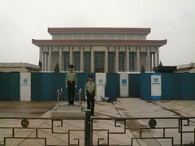From Mao to Morrison: Why Are Travelers Drawn to Controversial Tombs and Celebrity Graves?
Travel Blog • Eva Holland • 11.13.07 | 10:42 AM ET
Call it an odd sub-category of dark travel or the grief tourism twist on celebrity obsession. Either way mausoleum tourism is a force to be reckoned with. From Ho Chi Minh’s final resting place in Hanoi to Lenin’s tomb in Moscow, and of course Chairman Mao’s “mao-soleum” in Beijing, travelers line up every day to see the graves of powerful, controversial people. A monument to another much-loved and much-hated figure was just unveiled: a mausoleum for Yasser Arafat, on the grounds of his Ramallah compound.
Arafat’s story is much fresher than Lenin’s or Mao’s, making a visit to his tomb a far more political act. It isn’t likely to become a popular tourist destination anytime soon. Still, reading about it got me thinking about the different sorts of gravesites on travelers’ itineraries. There are the public tombs of revolutionaries and world leaders, like the three mentioned, and the graves of famous writers, actors, or musicians—Jim Morrison in Paris has to be the most famous example—whose plots are tucked away within larger cemeteries. There are the monuments to unknown soldiers whose remains represent their fallen comrades, and there are the tombs whose structures are the principal attraction, such as the Taj Mahal, say, or Egypt’s pyramids.
Why are we travelers drawn to these places? Are we simply checking another must-see off our to-do-before-we-die lists? Is it always simply to pay our respect? Or is there something else at work?
Looking back, I’ve drawn some distinctions for myself when visiting such sites. I’ve always been a bit queasy about the idea of visiting a grave purely as a tourist attraction, without any other connection to draw me there. In Vietnam I stood outside Ho Chi Minh’s mausoleum for a long while but never went in, while in India I spent far more time checking out the exterior of the Taj Mahal than I did the inner tomb itself. And I’ve never sought out the grave of a particular celebrity in a cemetery, but this past Sunday I spent the morning standing in front of Canada’s Tomb of the Unknown Soldier for a Remembrance Day ceremony, and I wouldn’t hesitate to visit the World War I cemeteries in France, or any of the battlefield monuments.
Anyone else created any rules for themselves within this particular tourism niche? Is one type of visit any less morbid or more tasteful than another?
 Photo of Mao’s tomb by
Photo of Mao’s tomb by
Roy Dixon 09.09.08 | 11:39 PM ET
I just came across this post and I had to comment. I have spent the past 25 years visiting graves and carving monuments, and I am still fascinated by the tombs of famous or infamous people. I think there is something inside us that is reassured by the physical “proof” that this person actually existed. Most people never get the opportunity to meet someone like Marilyn Monroe, Richard Nixon, Einstein or Billy the Kid, and to see the grave of such a person as this gives a kind of satisfaction that can’t really be described…but it’s there just the same.